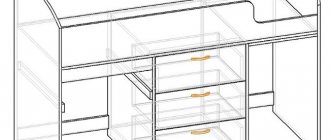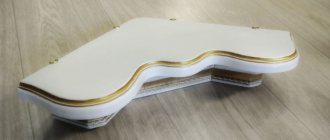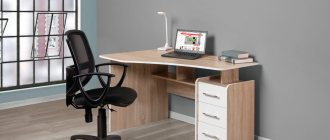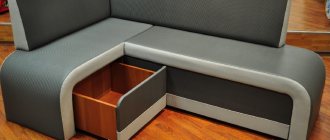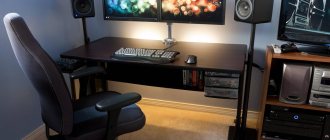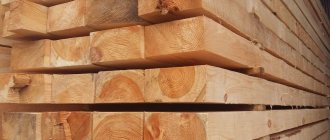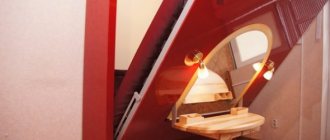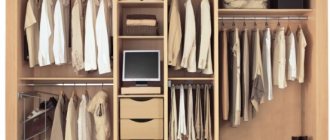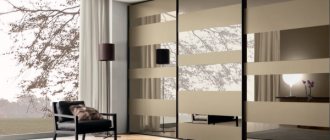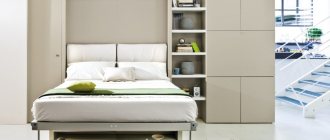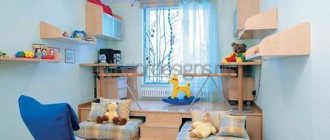Recently, in the interior design of apartments, special attention has been paid not only to beauty, but also to functionality, and the ability to properly use space. A corner shelf in a room is an excellent solution that will not allow a single centimeter of free space to go unused.
This detail can easily be used in every room. A wide selection of materials and various design variations allow everyone to choose a practical option for a modern interior.
Corner shelf in the room
The main purpose of the shelf
The design of rooms with functional, aesthetically pleasing shelves is actively gaining popularity. This piece of furniture allows you to use space as efficiently as possible. Many people use it to create a unique style in the interior.
On such shelves you can easily arrange various things so that they are always accessible, but the room remains in complete order. So, the following can be easily placed on the corner shelves:
- small household appliances;
- dishes;
- books;
- photos;
- souvenirs;
- personal hygiene items (if we are talking about the bathroom).
Corner shelves are often made from natural, environmentally friendly materials
Options for using shelves in different rooms
Corners for most rooms are difficult areas in terms of occupancy. However, the desire to use the entire area of any room is quite natural. Corner shelves in the interior look good everywhere: in the kitchen near the sink, in the bedroom next to the window and on the balcony, decorated with flowers.
Corner shelves for dishes
Corner shelves in Provence style
Main varieties
If you decide to functionally use the corner area by choosing a corner shelf for it, you should carefully study the types of structures. There are a large number of them. The simplest ones consist of 2 supporting parts and a board screwed to them on top. Even a novice craftsman can create such furniture with a set of simple tools at hand.
Table 1. Types of corner shelves
| Variety | Description |
| It is distinguished by the presence of three supports on which horizontal parts are firmly fixed. Externally, the bookcase looks light and elegant. Can be complemented with openwork carving. |
| It is advisable to install it in internal corners. When designed correctly, it becomes a harmonious recess in the wall. Most often, plasterboard sheets are used to create niches. The material attracts:
|
| Open shelf | Many people choose this type of design because it is easy to install on the outer and inner corner of the wall. The shelf is distinguished by the absence of vertical posts; each tier is separately attached to the wall. This creates the effect of lightness and airiness. |
| It differs from other species by the presence of its own walls on the sides. They not only represent an attractive decor, but are also load-bearing elements. |
Selecting material for work
The most important parameter for self-assembly of a corner shelf is the choice of material. All modern construction supply stores offer their customers a huge range of the following consumables:
- Wooden beams of various sections.
- Chipboard panels, MDF.
- Plywood.
- Metal profile pipes.
- Reinforced and sheet iron.
- Plastic and glass panels for assembly.
You can also use PVC pipes left over after renovations in your apartment (house). For pre-processing of parts and subsequent assembly, you will need a drill, jigsaw, welding and grinder, tape measure, construction pencil or marker, and level.
Fasteners for connecting parts together can also be purchased in stores: dowels, screws, self-tapping screws, metal corners.
For decoration and special impregnation, moisture-resistant oil, antiseptic and antipyrine, anti-corrosion composition, paints and acrylic varnish, PVC films with imitation of various materials (like brickwork, natural stone) are used.
For craftsmen with proper experience in wood burning or carving, you will need a set of appropriate tools. Making wall-mounted corner shelves will require purchasing mounting hardware.
Characteristics of materials used
Furniture departments offer a wide range of shelves, which are made from a variety of materials. When choosing a specific name, it is worth starting from the three most important factors.
- Operating conditions for the presented design.
- Stylistics of the room.
- Future load on the shelf (the design may have a decorative or functional purpose).
Be sure to analyze these factors, and then make your final decision.
It is easy to place indoor plants and decorative items on a multi-level structure
Table 2. The most common materials from which corner shelves are made
| Material | Description |
| Natural wood | Instances made of wood always look expensive. The use of rare breeds is not widespread due to the high cost of the product produced. Such a shelf should completely match the style of the room. The designs look elegant:
|
| MDF and chipboard | The presented material has a number of advantages, which include:
|
| Plywood | An affordable sheet material consisting of layers of wood veneer that are glued together. Advantages of plywood:
|
| Plasterboard and gypsum fiber sheets | Many people prefer to make their own shelves from plasterboard. This allows you to create a design that matches the interior of your home. It should be remembered that the material used does not withstand high loads. Therefore, heavy objects cannot be placed on it. If the design is being developed for the kitchen, it is necessary to use a moisture-resistant gypsum fiber sheet. |
| Plastic | The presented material is in most cases used for bathroom shelves. It has undeniable advantages, including:
|
| Glass | Glass options are highly valued in interiors where there are no clutter. The material creates an airy effect. The proposed designs fit harmoniously into the interior:
|
| Metal | Few people use metal shelves for home design. Its main advantage is strength, but heavy weights are rarely stored on such structures in the house. They are more suitable for:
|
Bathrooms: rationality and decor
Corner glass shelves are the most convenient and simplest option for storing various jars, creams, and shampoos. For convenient use, shelves with frequently used items are installed at a height of 80-150 cm. Below and above you can place items that are less often needed in everyday life. A corner plastic shelf is not exposed to moisture or temperature changes and is most often installed above the bathtub, near the shower counter. Thanks to a variety of design options and shades, you can choose a model to suit every taste.
It is better to mount shelves on wall anchors and stainless steel screws.
Corner shelves in the bedroom
Corner glass shelves
Location and purpose of the structure
When choosing the size of the shelf and its type, consider in which room it will be located in the future. It is important to create a complete interior with a functional detail.
The main purpose of the shelf is to optimize space in the house
Kitchen
For the kitchen, it is important that all the necessary items are always at hand, and not hidden in numerous drawers. It is best to use a compact, yet spacious wall design. Wooden models are most suitable for the kitchen, as they create a cozy atmosphere. A variety of designs allows you to choose an option that harmoniously complements the interior of the room.
Not the most practical solution for the kitchen would be models from:
- plastic;
- glass;
- metal
A good alternative to wood is decorated gypsum fiber sheet.
In a small kitchen, the shelf has a practical purpose, helping to keep necessary utensils in order.
Hallway
By using an original hanging shelf, you can easily decorate your hallway. Such furniture can easily perform several functions.
- A small shelf is suitable for storing keys and small items.
- The larger design allows you to easily accommodate all your bags.
- The tall design, complemented by figurines, will add sophistication to the hallway.
- The shelf with hooks is easy to use as a hanger.
For the hallway you should choose wooden furniture. Glass, metal and plastic cannot be called practical or universal. Take this into account when arranging the room.
A corner shoe stand will be a functional addition to the hallway
Bathroom
It's hard to imagine a bathroom without a convenient corner shelf on which all hygiene products are stored. Of course, numerous jars can be neatly stacked in a closet, but getting them out of it every time is not entirely convenient. It is better to have them at hand at all times.
For the bathroom they most often choose:
- glass structures with chrome stands;
- plastic shelves with metal racks.
It is important that such an interior detail is distinguished by its laconic execution. This makes it easy to care for, since high humidity in the bathroom causes rapid contamination of surfaces.
Manufacturers make the design as functional as possible by adding hooks, soap dishes
Living room
The living room is an ideal place where you can install a functional corner structure. Reading lovers will use shelving to store their home library. On the shelves you can easily place:
- family photos;
- decorative items.
During installation of the structure, you should definitely consider what load is planned on it. Fastenings must be as reliable as possible. Its size directly depends on the future purpose of the selected shelf. Decorative elements look good on compact models, and for a large library or collection, choose a spacious shelving unit.
Small corner shelves with carvings and shaped wooden details are often used as stands for icons
In many living rooms, wooden or metal corner shelves are used as flower stands. Glass specimens are much less common in living rooms. Designers advise not to clutter the shelves with numerous flowerpots and figurines. This eliminates the feeling of lightness that such a design is intended to add to the room.
In a spacious interior, options installed on external corners look harmonious. More often they are made of plasterboard or chipboard. You can design such an addition to the room yourself, taking into account the characteristics of the place chosen for the shelf.
For a small room it is better to purchase a compact design
Preparation of the drawing
An important stage of independent work is the preparation of a drawing, according to which further assembly of the structure will be carried out. The following parameters must be displayed on the diagram:
- General dimensions of this accessory.
- Dimensions of supports and horizontal strips.
- Assembly features.
It is important to identify any additional details: built-in spotlights, doors and mirror facades, fixing devices and limiting edges.
DIY shelf: advantages
A few years ago, no one would have thought of making home furniture themselves. It was believed that this was a sign of poverty and the inability to purchase a finished product in a store. Today, such a stereotype is completely destroyed. Everyone wants to emphasize their individuality in the interior by showing creativity.
Handmade furniture is a real home decoration
Of course, any project can be easily carried out by a qualified craftsman, but such services, as a rule, are quite expensive. When designing a shelf, you can refuse the help of a specialist and do everything yourself.
Drawing No. 1 Drawing No. 2 Drawing No. 3
Drawing No. 4
Hanging shelf with straps
If you need a decorative shelf for small items, the following option is perfect - a board suspended on straps.
To make a shelf you will need:
- 2 edged boards 300x750 mm, 30 mm thick;
- 4 leather belts, 75 cm long;
- 4 long screws with plastic dowels;
- 4 short screws;
- building level;
- ruler;
- sharp knife;
- drill.
Step 1: Preparing the belts
The cuts of the belts must be perfectly even, so if necessary they are trimmed with a knife. Fold each belt in half, press the ends to the table, step back 2 cm from the edge and drill a neat through hole with a drill. The same is done with the remaining three.
Step 2. Attaching the straps to the wall
Using a level, two points are determined on the wall at a distance of 60 cm. Holes are drilled and plastic dowels are inserted. The belt folded in half is applied to one of the holes and secured with a long screw - you get a large loop on the wall. Another such loop is attached nearby.
Step 3. Installing the shelf
A sanded board is inserted into the loops and aligned horizontally. To prevent the shelf from moving, the parts of the belts adjacent to the wall near the board itself are screwed with short self-tapping screws. Now another shelf is hung under this shelf, exactly repeating the steps described above. The result is a light and neat two-tier shelf. If desired, you can add another 1-2 tiers.
To make the shelves described above, you can use not only wood, but also plywood, as well as laminated chipboard sheets. The last option is used most often, since laminated chipboard is lightweight, high strength, practicality and durability. When assembling shelves from this material, all sections must be covered with a melamine edge to match the color of the sheet.
A simple method for making a corner shelf
When choosing material for a shelf, it is better to give preference to ordinary wooden boards or plywood, since they are not difficult to work with. If it is not possible to purchase a new wooden sheet, you can use the remnants of old furniture. When choosing raw materials, you need to take into account some features.
- Use only high-quality boards. If there are defects on it, such as rot, it is not suitable for creating shelves.
- Also, material with deep scratches and potholes would not be appropriate, since even after treatment it can quickly become unusable.
Boards with mold and rot are not suitable for creating furniture
Step 1. From the board you need to make blanks of the required size and shape. To do this it should:
- cut diagonally;
- rub it with sandpaper.
The result should be two triangular-shaped shelves. You will also need additional wood for the four posts. They must also be processed with sandpaper to eliminate chips, roughness and other irregularities.
Blanks
Step 2. Each design detail must have a high-quality appearance, so they should be:
- clean thoroughly;
- paint.
It is better to choose the color based on the design of the room.
It is better to paint with a roller - it does not leave streaks and ensures uniform coloring.
Step 3. Proper placement of the shelf affects its stability and aesthetic appearance. Therefore, it is important to carefully choose the location for its placement. After you determine the future location of the interior part being manufactured, measurements and markings are carried out using:
- regular pencil;
- building level.
Making markup is quite simple if you follow the following algorithm.
- Attach the stand to the wall.
- Level it using a level.
- Make a mark with a pencil.
A level will help you make the correct markings.
Step 4. The stand is attached to the wall using quick installation, for which holes are made with a drill. The racks must be installed according to the prepared markings. Then you need to double-check the correctness of the design using a level. Any deviations, even minimal ones, will negatively affect the quality.
Quick installation - dowel + nail
Don't know how to choose a drill for home use? Read in detail in a special article.
Step 5. You can use glue to fix the shelf to the racks. It must be applied in an even layer over the racks, having previously squashed any dust from them. Next, you just need to tightly fix the shelves on the prepared structure and wait a few hours for the glue to dry.
Apply glue The shelf will be suitable for use only after the glue has dried
This shelf is suitable for storing:
- various household items;
- indoor plants.
Please note: in order for the structure to support heavy objects, it should be reinforced with metal fastening systems.
Additional fastenings will increase the stability of the shelf
Additionally
In addition, you can additionally equip the shelf with some bonuses. For example, backlighting. It’s worth thinking about this at the preparation stage, and then preparing the necessary channels and holes before assembly. By installing such a shelf on the wall, it will not be difficult to run the wires and connect it to power.
DIY nightstand - detailed instructions for creating hanging and bedside modelsDo-it-yourself computer desk: master class on making, drawings and recommendations for choosing the design of a stylish desk
- Do-it-yourself chair cover: the best ideas and recommendations on how to sew a high-quality cover
How to make a corner rounded shelf yourself
A shelf is not just a practical design. It can also become an indispensable part of the interior of any room.
To create a corner shelf, it is not necessary to purchase expensive materials, such as glass. You can use no less practical and at the same time stylish options from:
- wood;
- sheet of plywood;
- chipboard;
- plastic.
Depending on the selected material of the shelf, its purpose will differ. To carry out work on installing the shelf, you will need to prepare material and tools.
Preparation of material
Step 1. Chipboard will be the best solution for making a shelf with your own hands. The size of the sheet is selected individually, taking into account the purpose of the structure. Using a pencil, make a marking in the form of a quarter circle on the selected material, and cut it out using a jigsaw.
Cutting out the shelves
Step 2. From the remaining material you need to make racks (2-4 pieces), their number depends on the required design of the entire structure. Each part should be sanded, and then holes for self-tapping screws should be drilled in them.
We fasten the racks together
Making holes for shelves
Step 3. To make the structure as reliable as possible, before fastening it is necessary to make markings using a level. Then holes are drilled in the wall to secure the studs using:
- drill;
- hammer drill
Now you can install the racks according to the markings. To strengthen the structure, you can use PVA glue.
We make holes in the wall to secure the shelves
Step 4. First you need to attach the shelf to the wall and check the accuracy of the measurements. If everything fits, you can begin further work. The parts are fastened to each other using self-tapping screws.
Fastening the shelves
If desired, the shelves can be decorated using slats of a semicircular section, making handrails out of them. This decor will protect items on the shelves from falling off.
Corner shelf materials
Corner shelves made of plastic, organic glass or chromed metal are ideal for the bathroom. The choice of material for making shelves is influenced by the overall design concept of the room. The texture of the material must correspond to the functional purpose of the room.
This makes it possible to individually design a room and decorate certain areas of the home in an individual style. Corner shelves can be decorated with LED lighting built into the structure or small spotlights.
Shelves are fixed to the wall in different ways - hidden and decorative. To decorate corner furniture structures, cables, stones, chains, and textile materials are used.
Despite the fact that corner wall shelves are the simplest furniture design, the role of these pieces of furniture in organizing human life inside the home is great. In addition, they perfectly solve the issue of saving space, increasing its functionality and practicality.
The possibilities of this piece of furniture in decorating a residential or office space are unlimited. For almost any interior, a wall shelf is universal and will organically fit into the space, turning an apartment, office, room with any purpose into a stylish and ultra-modern place.
Shelves in the house are one of the most optimal rational ways to use free space. They can act as a separate design feature and at the same time successfully accommodate many necessary things.
Corner shelves on the wall are especially popular among owners of small living spaces, where you need to place a lot, but there is not enough space. The modern market offers many variations of them, ranging from plastic corner shelves for the bathroom to real works of art in the form of wooden or glass structures. We will now tell you how to use such comfortable and practical furniture in your home.
Corner shelves for the kitchen
We spend a lot of time in the kitchen, so an atmosphere of comfort and warmth should reign here. However, it can be difficult to complement the interior with some decorative items because in the room where food is prepared there is always a lot of kitchen utensils that should be placed in the most convenient way. This is exactly what corner kitchen shelves are for. They help turn wasted space into a very useful department.
In order not to place a hodgepodge, a sugar bowl, a pepper shaker, a set of jars for seasonings, spices, cereals, a vase with fruits or sweets, and much more all over the desktop, it is enough to install a multi-tiered wooden corner shelf for the kitchen on the wall, and all this will be collected in one secluded place. You can also store large vases, bowls, flower pots on it, it looks very original and modern. It is very convenient to use corner shelves made of plasterboard. They need to be “built” manually, but the result is pleasantly pleasing because such a design can serve as a corner shelf for a TV in the kitchen, and just a place to place kitchen figurines, candles, paintings, children’s crafts or favorite photos.
Corner shelves on the wall for the living room
When choosing shelves for the most important room in the house, it is very important to take into account the overall style of the interior. Made from wood or chipboard in a trendy dark brown wenge color, corner shelves will give the room a feeling of luxury.
They blend harmoniously with furniture of the same color in the living room or study. A multi-tiered white corner shelf can also become a light, unobtrusive decorative element in the living room. Both options are suitable for storing family photos, lamps, awards, decorative items, books, magazines, etc.
Corner shelves for flowers
This piece of furniture is very popular among all home “amateur gardeners”. Corner shelves for flowers are made mainly of metal, wood or chipboard. Forged shelves attract with their flexible lines, original shapes and are able to support the largest pots of greenery. Wooden
103583
Shelves arranged in niches
Niches are an excellent area for arranging shelves in the bedroom. Their shape can be any: narrow or wide, round or rectangular, deep or not too deep. This is not only a familiar interior classic, but also a kind of “highlight” of the room.
Some prefer built-in designs with open sections in niches, while others prefer closed cabinets. Often niches serve as an area for installing corner shelves in the bedroom.
Why is Netflix so popular?Orthopedic mattresses with independent springs, what is special about them
- Posters and reproductions in the interior
According to experts, the best place to equip niches is the distance between window openings, the wall opposite the bed or the area near it.
The choice of one or another option is made during redevelopment or when drawing up a design project for the premises, because it is necessary to create special structures and make some calculations.
Manufacturing process: step-by-step instructions
This will make the shelves more attractive in appearance.
The most important thing is to always check the evenness of the markings using a building level.
You should align the sides with extreme precision and check that the angle is right.
The glue should dry for several hours, after which the shelf can be used.
You can store household items, decorations and even indoor flowers on it. However, if the shelves are used to store bulky and heavy items, then such fasteners will not be enough. The structure can be strengthened using special metal elements that are installed from below. Such elements are attached to the racks and the shelves themselves using screws.
Exact adherence to the required parameters will allow us to produce a product of proper quality.

